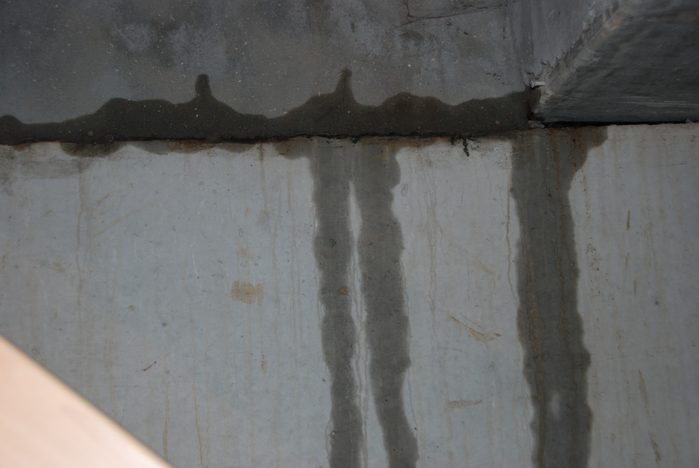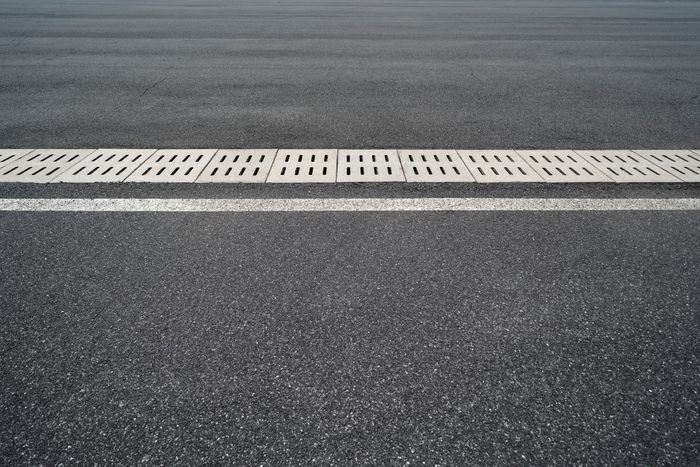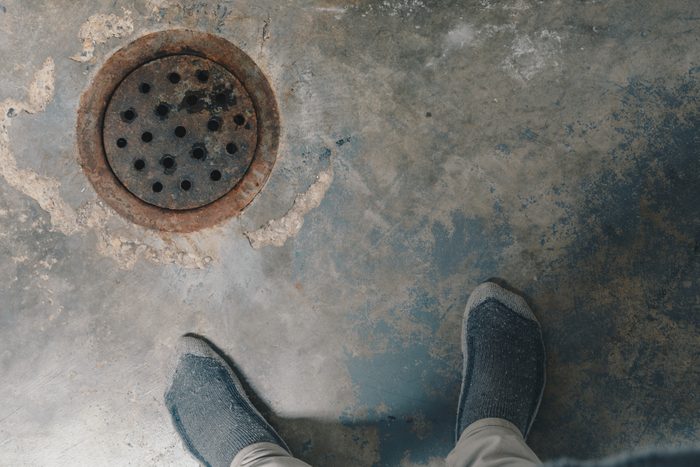Getting rid of water in a basement with persistent flooding issues is a special kind of problem. These types of floor drains can help.
Types of Basement Floor Drains and Their Best Uses

French drain
This consists of a gravel-embedded perforated pipe installed in a trench that slopes toward a drainage point. It’s a good solution for flooding caused by groundwater. Typically installed six to 24 inches deep, it can also control water seepage through walls.
This type is sometimes called drain tile because it was made from old roofing tiles in the days before plastic pipes. The gravel is usually left exposed on the floor surface, but you can cover it with a metal or plastic grid if you choose.
Pros: A French drain is extremely beneficial to collect excess groundwater and is appropriate for unfinished basements.
Cons: You need a professional to install it.

Curtain drain
This is so similar to a French drain that the two are often confused. The difference? A curtain drain is shallower.
It consists of a perforated pipe embedded in gravel and installed in a sloping trench. The shallow placement allows the drainage pipe to catch and redirect water seeping in through the walls.
Because you don’t dig it as deep, a curtain drain is easier to install than a French drain. It can be an adequate drainage solution when groundwater flooding isn’t likely.
Pros: A curtain is fairly easy as well as affordable to install and maintain. It’s ideal for sloping terrains.
Cons: Curtain drains have limited capacity and may not be able to handle large amounts of runoff.

Channel or trench drain
This is simply a sloping trench covered by a metal grid, installed around the floor perimeter or in the middle of the floor. It doesn’t soak up water; it directs it to a sump pit or some other place where it can drain safely. It provides insurance against flooding from plumbing leaks and similar accidents. The basement floor must slope toward a channel drain, so the trench is usually dug at the lowest point. Installation may necessitate resurfacing the floor to give it the necessary slope.
Pros: Trench drains are very effective in offering structural protection and minimizing soil erosion. They can be used in residential, commercial and industrial units.
Cons: It’s more prone to getting clogged with debris. The grates may lead to a tripping hazard if improperly maintained. Besides, if the installation isn’t done precisely, a trench drain can stem damages in the building.

Standard floor drain
Perhaps the most familiar of all basement drains, the standard floor drain features a round or rectangular grid covering the hole. It sits at the lowest part of the floor, collecting standing water that comes in through the walls or elsewhere. It sends the water through an underground pipe to the plumbing system or to a sump pit.
If it connects to the plumbing, this type of drain is best installed during initial construction because it needs a P-trap and vent to prevent the release of sewer gases into the basement. Piping a floor drain into a sump pit avoids such complications.
Pros: A floor drain effectively removes standing water. It is ideal if your building has many wet floors and bathrooms.
Cons: It is hard to install in existing buildings since you may need to dig up concrete and re-fix the plumbing lines.

Sump pit and sump pump
A sump pump and sump pit are often used in conjunction with another drainage network. But even without supplemental drainage, a sump system can effectively protect a basement from flooding due to a high water table.
Groundwater flows into the sump pit, dug below the floor. When it rises to a dangerous level, the pump switches on to empty the pit. Sump pumps are commonly found in basements built in poorly draining soil or low-lying areas subject to flooding.
Pros: A sump system is reliable even during heavy rains. It also keeps the growth of molds in check and doesn’t depend on external barriers to function.
Cons: Since it operates on electricity, you may require a battery backup in case of power cuts. If not maintained regularly, it can get clogged.

Exterior perimeter drain
Exterior drains installed around the perimeter of the foundation collect and redirect water before it seeps into the basement. In locations with high groundwater or heavy runoff, they are often French drains dug along the foundation wall or even at its base. When runoff is the only issue, a channel drain may do the job.
Sometimes, an exterior drain is all a basement needs to stay dry. But in locations with high groundwater, exterior drains are only part of a complete drainage system.
Pros: An exterior drain can last for around 30 years. It can control moisture levels very well.
Cons: It comes with a high installation cost and can cause damage to the building if retrofitted.
French drains vs traditional floor drains
If you have to compare a french drain vs. a floor drain, let’s say both help manage unnecessary water, but their functionality and installation are different. A french drain is part of an outdoor drainage system that diverts surface or groundwater water away. It is optimal for preventing yard flooding or safeguarding your building from water buildup.
On the other hand, a floor drain is usually fixed inside a building, in a basement or garage, to collect and drain away water that gathers on the floor. Floor drains connect directly to a sewer line and have a trap to block sewer gases.
Common Basement Waterproofing Tips
Regular cleaning and maintenance go a long way in ensuring that your basement is intact. Here are some tips:
- Choose the right basement floor drain based on your needs, budget and building layout.
- Clean debris as and when it accumulates on the grates.
- Ensure your exterior drainage is functioning properly.
- Put in place a dehumidifier in case of too much moisture or mold growth.
- Apply a waterproof coating on the walls of the basement structure. You can also use moisture-resistant materials like vinyl flooring in the area.
- Inspect pipes, plumbing lines and water heaters periodically to arrest leakages.
FAQ
Can I install a basement trench drain myself?
Yes, it is possible to install a basement trench drain yourself, but it’s better to hire a professional plumber since it is labor-intensive and requires precision. If not done correctly, you may have to deal with many issues later.
Sources:
- Groundworks: “Concerned About Your Basement Drain?”
- Dura Trench: “Everything You Need to Know About Floor Drains”
- USDA: “Preventing basement leakage in treated-wood foundations”
- This Old House: “Basement Waterproofing 101: A Comprehensive Guide”



















